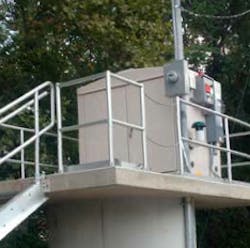First for the Future
New utility projects in the City of Marietta, Ohio, must align with the municipality’s forward-thinking sustainability program—an initiative with the goals of conserving energy, improving water quality and reducing the carbon footprint, labor costs and operating expenses of city facilities.
Scope
The city’s aging Gilman Avenue Lift Station was the first of 12 stations to be upgraded as part of a capital improvement plan at the city’s wastewater treatment plant (WWTP). The new Gilman duplex station was designed as a prototype to achieve higher capacity, reduce energy use and establish a cellular-based SCADA network at the WWTP.
Solution
For the upgrade, city engineers selected two Xylem-brand model 3127 Flygt N-pumps, based on their energy efficiency, clog-resistant features and adaptability to the 11 additional lift stations slated for eventual replacement. Flygt representatives worked with plant engineers to reduce pump horsepower ratings from 12 hp to 11 hp, keeping the equipment within budget while still delivering the desired performance curve. The pumps are monitored and controlled by a Flygt AquaView SCADA system at a centralized station within the WWTP.
Another engineering feature also favored selection of the high-performance pumps and companion SCADA for the prototype: The Flygt N-technology impeller design features an innovative ability to move axially upward to relieve a clog, easing the passage of blockage material under even the most difficult conditions.
Result
The retrofit increased the Gilman Avenue Lift Station capacity to 0.205 mgd and applied a new generation of pump and controls engineered for energy savings and clog resistance.
“The pumps we selected were supplied with the manufacturer’s guarantee of 25% energy savings, which supports our sustainability initiative,” said City Engineer Joe Tucker, P.E.
The Flygt pumps have far exceeded the utility’s desired energy efficiency.
The station is the first in the state to be connected to a Flygt AquaView SCADA system, which connects to the main plant via cellular-based 4G communications. In addition to remote monitoring and control of the pumps, the technology helps to identify and address inflow and infiltration locations that pose environmental threats and lead to wastewater treatment costs. The SCADA was networked with a total of 13 lift stations coinciding with the completion of the replaced facility, and the technology’s multitasking and remote analysis capabilities prevent unnecessary dispatches of maintenance crews to correct problems indicated at lift stations.
“An eight-month comparison of our electric utility bills reveals a 58.9% average reduction in that operating cost since the new pumps entered service,” said Wastewater Superintendent Steve Elliott. “As we replace the pumps at other stations with the prototype package, the savings should be very significant.”
The controls are located in a Pumpcon valve vault mounted on a platform elevated 1 ft above the 100-year floodplain of the Muskingum River, which runs approximately 40 ft from the station. The design reduces future risk to the controls and eliminates the cost of excavating and building another pit adjacent to the dry-pit pump installations.
In daily operations, the impeller’s clog-clearing design has eliminated the energy-consuming drag often imposed by stringy materials, cleaning wipes and other non-flushable material that can entangle conventional impellers.
“Thus far, we’ve experienced no plugging of the new pumps at the rebuilt station,” said Elliott.
